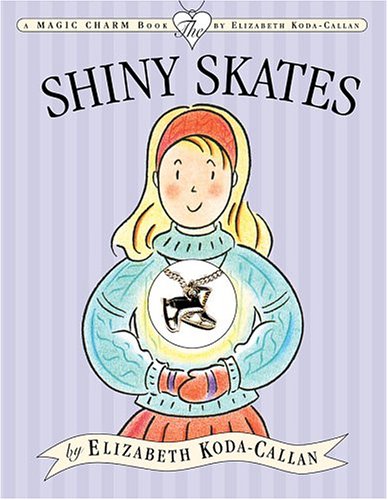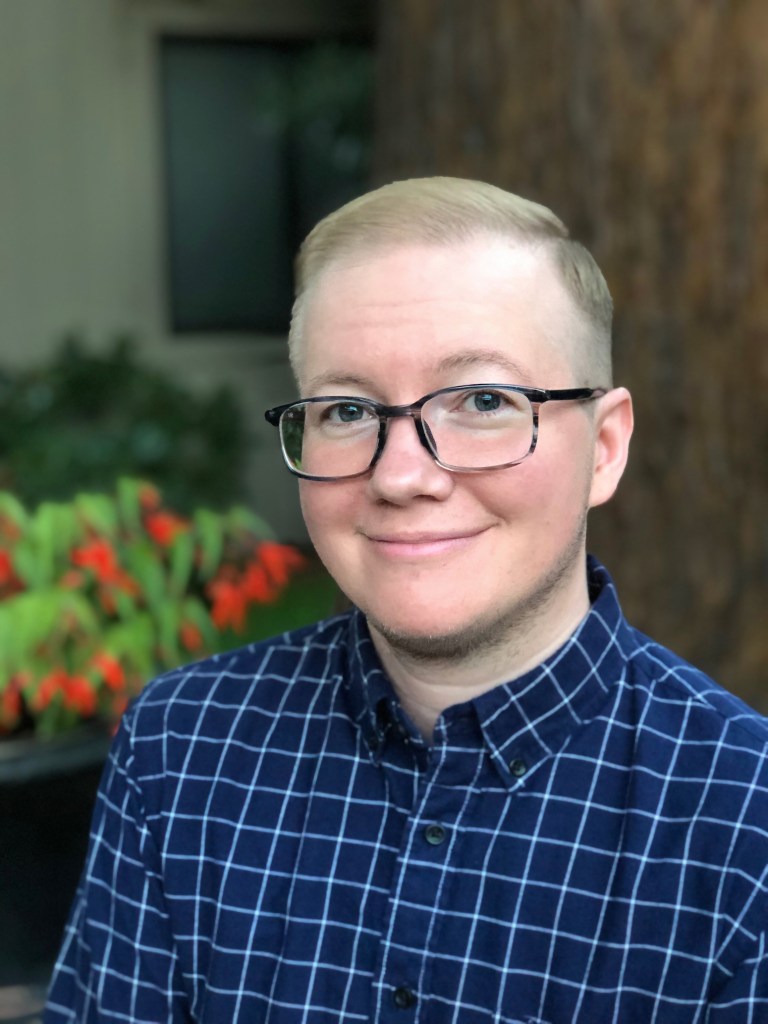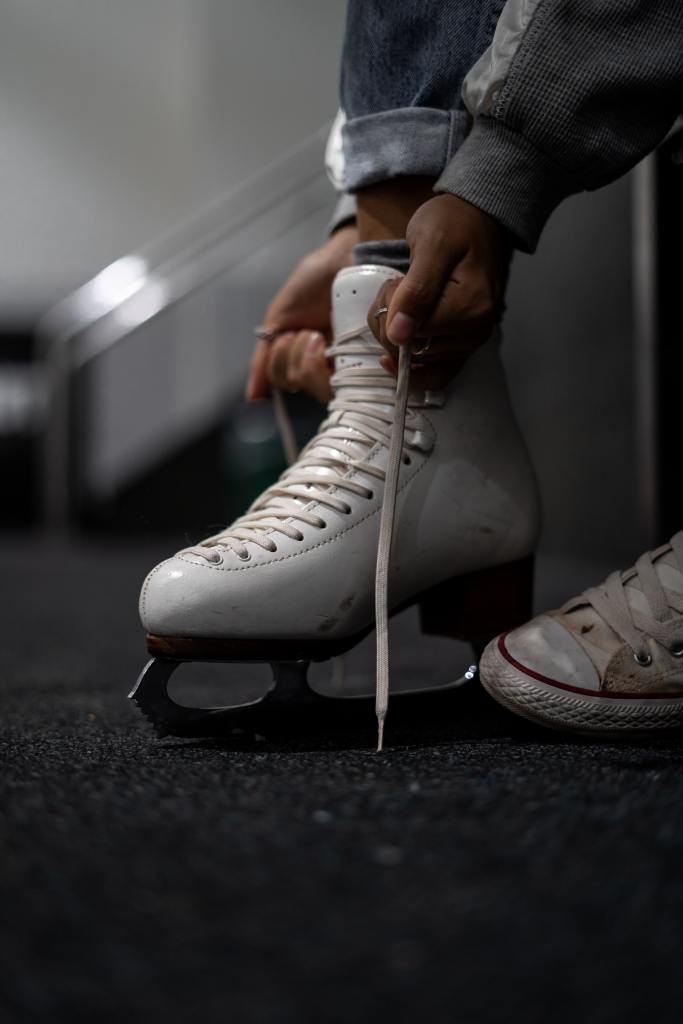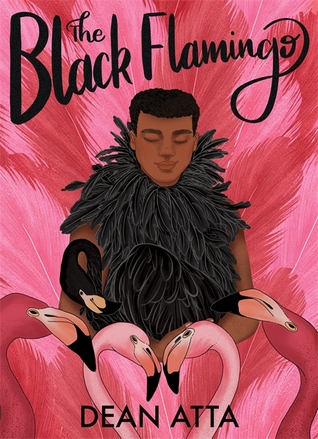I grew up as a sports-loving tomboy in St. John’s, Newfoundland, and one of my earliest memories is of my toddler body being stuffed into a snowsuit and skates, and thrust onto the ice by my grandfather. I leaned my torso on the seat of a rickety wooden chair that scraped along in front of me as I learned to clop my way around a worn rink and lots of bumpy pond surfaces. When I got steady enough on my feet, being a girl, I was funnelled into figure skating classes, while my masculine peers were shuffled off to hockey. I did local competitions until I was 10, when a knee injury from horseback riding kept me on crutches for a year, and I was relegated to recreational skating for the rest of my days. Still, ice skating has been a huge source of joy in my life, and every winter I still haul my neon purple and pink skate bag, monogrammed with my dead name, out to the rinks in Toronto. I wear knee pads these days.

When I first came across A.J. Sass’ book, ANA ON THE EDGE, the first thing that came to mind was one of my 1990s childhood favourites, a book called THE SHINY SKATES, by Elizabeth Koda-Callan. Truly a relic of the 90s (although it was reprinted in 2004 by Workman Publishing), this was part of the Magic Charm books – a series of chapter books that came with charm necklaces for the reader to wear along with their characters. I wore mine religiously.
Around the time that THE SHINY SKATES was released was also when American Olympic figure skater Tonya Harding’s career came to a close due to her possible involvement in a scandalous event in which her skating rival, Nancy Kerrigan, was assaulted and injured at the rink. Both skaters competed in the 1994 Olympics, where Kerrigan won a silver medal and Harding finished eighth. I still remember how public perception of Tonya Harding and her less feminine presentation on the ice coloured my entire experience of learning how to skate as a young, gender non-conforming athlete. (If you want to learn more about Harding and her story, journalist Sarah Marshall wrote a great piece about her, and later did a two-part podcast episode about her on You’re Wrong About.)

ANA ON THE EDGE is an #OwnVoices middle grade novel about a non-binary figure skater, written by a non-binary figure skater, and all I can think every time I think about this book is how the world has changed since I was a kid. I can’t even imagine how life-changing it would have been for me to have gotten my hands on this book back in the body-shaming mid-90’s, when I was mortified by how my muscular, chubby body looked in my skin-tight, sequinned figure skating dresses… if Tonya Harding couldn’t pull them off, how could I be expected to? The gentle exploration of gender, identity, and self-perception that is navigated with such charm in ANA ON THE EDGE could have been a balm to my soul back then, as it is now.
I am so honoured that author and figure skater A.J. Sass was so generous and receptive when I reached out to see if they would collaborate on a post for this site about ANA, and my interview with them is below. I would be remiss not to mention that not only is A.J. an autistic author with an interest in neurodivergence representation in fiction, they are a much more accomplished skater than I could ever dream to be! Aside from writing books, A.J. is a US Figure Skating double gold medalist in Moves in the Field and Free Skate, a silver medalist in Ice Dance, and a member of the 2018 national bronze medalist and 2019 national silver medalist Masters synchronized skating team, IceSymmetrics. (Insert my fan face here!) Now living in San Francisco, ANA is their debut novel, and it was released in October, and is available for purchase now!
When I asked A.J. what books by Black authors they would recommend alongside ANA, they struggled to narrow it down to three choices… Kacen Callendar’s KING AND THE DRAGONFLIES (a fan favourite in these parts), THE BLACK FLAMINGO, by Dean Atta, and Kim Johnson’s THIS IS MY AMERICA.
Interview with A.J. Sass, author of ANA ON THE EDGE

When I first encountered ANA ON THE EDGE, I was so thrilled for two reasons. One, there isn’t a lot of #OwnVoices non-binary representation for this age group yet, and two, I would have loved a book like this growing up. What do you think your young self would have thought of Ana and of this story?
I definitely didn’t know I was non-binary when I was Ana’s age. In fact, I’m not even sure if the term had been coined yet, officially! What I do know is that I would’ve gravitated toward a book like this on the shelves because I was an avid fan of skating as a kid. I started group class lessons all the way back when I was seven. And I think reading about Ana, a rising star in the sport of figure skating who realizes she* is uncomfortable with some of the gendered aspects within the sport, would have been revelatory for me as someone who always felt a little prickle of discomfort when I encountered similar binary components as a skater.
I can’t know for sure what I would have thought of Ana, or Hayden, her new friend who is a transgender boy, but I suspect that seeing a mirror of my own feelings reflected in someone else would have given me a solid starting point to exploring my identity much earlier in my life.
*Just as a heads up, I’m referring to Ana with female pronouns because Ana hasn’t chosen a new set by the end of the story. Non-binary people use a variety of pronouns, like gender neutral and even male and female pronouns in some instances (e.g., I use he/him and they/them pronouns interchangeably). In Ana’s case, she’s still exploring what feels best for her.

You’ve competed in figure skating, ice dance, and synchronized team skating. How did your own experiences in this artistic sport factor into your work on ANA?
As I mentioned earlier, I started skating when I was a child and I remain active in the sport now. As a kid, my discomfort associated with wearing skating tights and dresses was more of a subconscious undercurrent rather than something I was actively aware of. I think kids today are often more aware that the LGBTQIA+ community exists, even if they don’t know precisely how they fit into it. So I made sure to reflect that in Ana’s narrative, even though it took me until adulthood myself to pinpoint why I was uncomfortable with skating’s gendered components.
One of my favorite memories in the sport is of the friendships I made, and the moments my training-mates and I would goof off in between lessons during practice. Because at its core, skating is a really fun activity, even for kids like Ana who are very serious about their training. An early scene where Ana’s best friend, Tamar, challenges her to perform a cartwheel on ice comes directly from my own experiences. Here’s some proof:
Being a marginalized publishing professional can be super challenging. Your book is with a Big 5 publisher – one of the Hachette imprints – and that’s a really big deal! What has your experience been like working with an agent and an editorial team at a big publishing house on a story featuring a protagonist who is questioning their gender? What would you say the most fulfilling part of this process was, and what was the biggest challenge?
I feel like I’ve been supremely fortunate to work with my agent, Jordan Hamessley, and the entire team at New Leaf, as well as ANA’s publishing team at Little, Brown Books for Young Readers.
Working with Jordan has been wonderful and affirming. An example: When we were preparing to go on submission with ANA, Jordan made sure I was comfortable being out as a non-binary author before pitching me as such to editors. Now that ANA is published, I absolutely see where Jordan was coming from since the vast majority of author panels I’ve been on and interviews I’ve done have referenced my experience of being non-binary in some way. I’m proud to be out and open about who I am, but I definitely appreciate Jordan preparing me to think about how that choice would impact the way people approach questions about me and my book.
My editorial team at Little, Brown has also been fantastic. Even so, working on a story with a non-binary protagonist who hasn’t made a decision to change her pronouns yet by the end of the story presented a challenge for all of us.

About a year ago, right around the time we were finalizing the book summary that would appear on ANA ON THE EDGE’s dust jacket, the use of female pronouns in reference to Ana started feeling off to me. I really couldn’t explain it at first. We’d used female pronouns for the Publishers Weekly announcement when ANA first sold and we used them on internal email communications as well. So why was it bothering me to see them on the inside flap of what would eventually become the book’s dust jacket?
Eventually, I realized my concern was that prospective readers would be unfamiliar with the nuances of Ana’s story and what it even means to be non-binary. I worried that cisgender readers would see those female pronouns and immediately make the assumption that Ana is a girl who decides to become non-binary, rather than a non-binary kid discovering that’s who they’ve always been.
Then I proceeded to worry that my publisher would be annoyed if I asked to change the wording after I’d already approved the final copy. But ultimately, this became one of the most fulfilling aspects of the publishing process for me because my editors were incredibly receptive to my feedback. They were happy to rework the copy so that pronouns aren’t referenced at all on the dust jacket, or marketing and other promotional materials. Now I feel like readers can enter Ana’s world without any misconceptions about gender identity and come to their own conclusions as they immerse themselves in the story.

In this story, you decided to include not only Ana, a non-binary protagonist, but you also introduced readers to Hayden, a transgender boy. Was it important to you to include more than one trans character in this book, or did that just happen organically as you were writing? In addition, how did you make sure that you were doing both of these identities justice in your representation of them in this book?
It was an intentional choice to include two trans characters because I wanted to highlight how no two trans experiences are the same. Hayden’s known who he is for a while by the time he and Ana meet, whereas Ana is just starting to explore the layers of her identity. As I touched on in an earlier answer, I think it can sometimes be a revelation to see an aspect of yourself reflected in someone else. That’s what happens when Ana meets Hayden: Hayden’s identity doesn’t match Ana’s precisely, but she recognizes a shared commonality, one that spurs her to dig deeper and learn more about herself.
In terms of representation, I’ve identified as a transgender man and non-binary at various points in my life. There are parts of my experience with those two identities in the representation of both Hayden and Ana. Since trans experiences can vary greatly from person to person, I also had authenticity readers provide further feedback.

What is one thing that you would want your readers to know about ANA ON THE EDGE? Similarly, what do you wish you could tell adults who are going to choose this book to put in a young reader’s hands?
My answer here applies to both kids and adults: It’s okay not to have everything figured out about yourself all at once. It’s fine if you do, of course, but I think something I struggled with when I was younger was a concern that I might change my mind later or realize I was wrong about my identity after I’d already come out to my friends and family. I worried about burdening others if I had to come out again and ask them to use a name and set of pronouns that fit me better.
People aren’t static. We are constantly changing and evolving. The same can be true about identity, and there is no shame in coming to a better understanding of yourself, no matter what age you are. I hope Ana’s story helps readers embrace uncertainty and consider it an opportunity to get to know themselves even better.
PS, if you enjoyed this post, please consider leaving me a tip! It only takes a minute, and it allows me to keep creating content just like this, buying food for my pets, and pursuing my career as a literary agent!




Pingback: Ana on the Edge by A. J. Sass – ACHUKA Children's Books UK